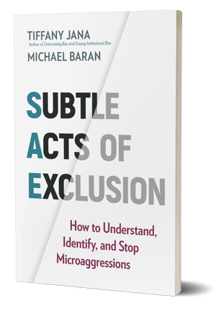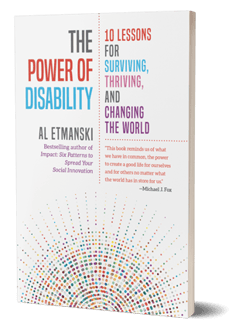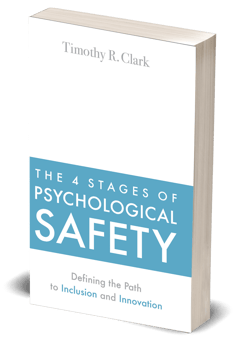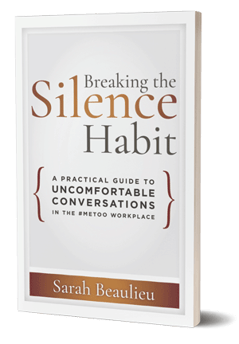Diversity and inclusion are so frequently used in the same breath that they’re thought of as a singular concept. And when did we add ‘equity’ to the mix? Diverse representation in a workplace means nothing when employers don’t actively encourage and invite employees to participate and contribute - it’s essential to inclusion. When you hire a diverse group of people—such as women, people of color, LGBTQ+, people with disabilities, and members of other minority groups—without a welcoming and inclusive organization to receive them, employees will continue to report feeling excluded or unheard because of their identities.
In other words, diversity alone does not facilitate inclusion; that crucial work must be done in tandem with meeting diversity metrics in hiring and employee development. These resources will give you the actionable tools your DEI program needs to succeed.
1. Subtle Acts of Exclusion
 How do we nurture inclusive cultures in increasingly diverse settings? While the DEI movement has made huge strides for workplaces everywhere, there is still work ahead about the subtler everyday actions that normalize exclusion. 'Microaggression' is a relatively well-known term, but not everyone fully understands what they are, how they affect people, and how to stop them.
How do we nurture inclusive cultures in increasingly diverse settings? While the DEI movement has made huge strides for workplaces everywhere, there is still work ahead about the subtler everyday actions that normalize exclusion. 'Microaggression' is a relatively well-known term, but not everyone fully understands what they are, how they affect people, and how to stop them.
Tiffany Jana and Michael Baran offer a clearer, more accessible term in this book: subtle acts of exclusion, or SAEs, which emphasize the purpose and effects of these actions and names these actions as what they really are. Whether in the form of exaggerated stereotypes, backhanded compliments, unfounded assumptions, or objectification, SAEs are damaging to our peers by making them feel marginalized and invalidated. Jana and Baran give simple, clear tools to identify and address such acts, offering scripts and action plans to help people everywhere have these conversations in an open-minded, honest way. Use this book as a go-to resource to build strong, inclusive workplaces that support healthy communities.
Subtle Acts of Exclusion | Berrett-Koehler | Barnes & Noble | IndieBound | Bookshop | Amazon | Audible
2. The Power of Disability
 Inclusive workplaces are accessible to people of all backgrounds, shapes, and sizes. Yet too often, those who developed the conversation around accessibility are left out of the picture. Al Etmanski’s mission in The Power of Disability is to push back against ableism and highlight how people with disabilities, whether those disabilities are seen or unseen, are authoritative sources on creativity, resilience, and adaptability.
Inclusive workplaces are accessible to people of all backgrounds, shapes, and sizes. Yet too often, those who developed the conversation around accessibility are left out of the picture. Al Etmanski’s mission in The Power of Disability is to push back against ableism and highlight how people with disabilities, whether those disabilities are seen or unseen, are authoritative sources on creativity, resilience, and adaptability.
Etmansksi lays out ten lessons we can learn from people with disabilities, using examples from well-known names like Stephen Hawking, Helen Keller, Stevie Wonder, Michael J. Fox, and Temple Grandin. Other examples are less famed, like Caroline Casey, who became the first Western female mahout (elephant rider) and rode solo across India, experiencing the journey while legally blind, or Aaron Phillip, a trans woman with cerebral palsy who is a professional model discovered through social media. This book provides the insight and inspiration needed to kickstart a thoughtful, actionable dialogue about inclusion and center the people who have developed the language, tools, and resources on building truly inclusive and accessible spaces.
The Power of Disability | Berrett-Koehler | Barnes & Noble | IndieBound | Bookshop | Amazon | Audible
3. The 4 Stages of Psychological Safety
 Productivity and workplace culture suffer when employees don’t feel safe enough to contribute their ideas, and critiques, to an organization. Fear has a profoundly negative impact on engagement, learning, curiosity, efficacy, and especially inclusion. Without a sense of safety, employees will continue to feel alienated at work. Until now, we lacked the resources to talk about the critical elements of what constitutes an inclusive workplace. We've since learned that the main ingredient is to create lasting psychological safety. Psychological safety allows team members to take risks without repercussion, reprisal, or the risk of tarnishing their standing and reputation.
Productivity and workplace culture suffer when employees don’t feel safe enough to contribute their ideas, and critiques, to an organization. Fear has a profoundly negative impact on engagement, learning, curiosity, efficacy, and especially inclusion. Without a sense of safety, employees will continue to feel alienated at work. Until now, we lacked the resources to talk about the critical elements of what constitutes an inclusive workplace. We've since learned that the main ingredient is to create lasting psychological safety. Psychological safety allows team members to take risks without repercussion, reprisal, or the risk of tarnishing their standing and reputation.
Timothy Clark, a social scientist and organizational consultant, provides a foundational framework to move people through four successive stages of psychological safety that permeates throughout organizational cultures. First, people feel included and accepted; then, they feel safe to learn, muster the strength to contribute, and finally, challenge the status quo. This thoughtful and pragmatic guide demonstrates that if you banish fear, install true performance-based accountability, and create a nurturing environment that allows people to be vulnerable as they learn and grow, they will perform beyond your expectations.
The 4 Stages of Psychological Safety | Berrett-Koehler | Barnes & Noble | IndieBound | Bookshop | Amazon | Audible
4. Bridging Differences for Better Mentoring
 Studies have shown that mentorship is one of the most effective tools in managing successful diversity, equity, and inclusion programs. And it makes sense - mentors are invested in growing their mentees to be successful and have the power and influence to uplift and center voices from the margins. But that doesn’t mean that mentor-mentee relationships don’t face challenges of building relationships across differences. One unintended outcome of the #metoo movement reported that men were less likely to agree to mentoring women for fear of being accused of harassment, further excluding women from positions of influence held overwhelmingly by men.
Studies have shown that mentorship is one of the most effective tools in managing successful diversity, equity, and inclusion programs. And it makes sense - mentors are invested in growing their mentees to be successful and have the power and influence to uplift and center voices from the margins. But that doesn’t mean that mentor-mentee relationships don’t face challenges of building relationships across differences. One unintended outcome of the #metoo movement reported that men were less likely to agree to mentoring women for fear of being accused of harassment, further excluding women from positions of influence held overwhelmingly by men.
In Bridging Differences for Better Mentoring, Lisa Z. Fain and Lois J. Zachary present an evidence-based, practical guide for helping mentors develop the level of cultural competency needed to bridge differences and foster genuine relationships founded in connection, not fear. Firmly rooted in Zachary’s well-known four-part mentoring model, the book offers an array of accessible tools and strategies designed to help you increase your self-awareness and prepare you to embrace and leverage differences in your mentoring relationships.
Bridging Differences for Better Mentoring | Berrett-Koehler | Barnes & Noble | IndieBound | Bookshop | Amazon | Audible
5. Breaking the Silence Habit
 In the wake of the #MeToo movement, employees and leaders are struggling with how to respond to the pervasiveness of sexual harassment. For too long, we've lived in a culture where people who've experienced sexual harassment do not feel safe enough to bring the issue into a public sphere and will remain silent - an injustice in itself - which prevents people from realizing their potential and process their trauma in spaces of belonging. Increasing workplace diversity, especially women in leadership positions, has uncovered just how often sexual harassment happens. To promote and cultivate an inclusive workplace, leaders need to know how to navigate this uncertain, emotionally charged terrain properly.
In the wake of the #MeToo movement, employees and leaders are struggling with how to respond to the pervasiveness of sexual harassment. For too long, we've lived in a culture where people who've experienced sexual harassment do not feel safe enough to bring the issue into a public sphere and will remain silent - an injustice in itself - which prevents people from realizing their potential and process their trauma in spaces of belonging. Increasing workplace diversity, especially women in leadership positions, has uncovered just how often sexual harassment happens. To promote and cultivate an inclusive workplace, leaders need to know how to navigate this uncertain, emotionally charged terrain properly.
Sarah Beaulieu provides a new skills-based approach to addressing sexual harassment prevention and response in the workplace, including using underdeveloped skills like empathy, situational awareness, boundary setting, and intervention. Beaulieu outlines a five-part framework for having conversations and shows that, by embracing these conversations, we can break the cycle of avoidance and silence that makes our lives and workplaces feel volatile and unsafe. This book shows that uncomfortable conversation is a core skill required to enable everyone to bring their full talent and contributions to safe, respectful, and inclusive workplaces.
Breaking the Silence Habit | Berrett-Koehler | Barnes & Noble | IndieBound | Bookshop | Amazon | Audible
In the midst of upheaval and transformation, we need to charge ahead together to create adaptable and safe work environments for everyone. These books will help you navigate the essential territory of diversity, equity, and inclusion to foster employee trust and retain valuable talent in the long-term.



